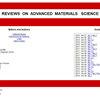Modeling the strength parameters of agro waste-derived geopolymer concrete using advanced machine intelligence techniques
IF 3.6
4区 材料科学
Q2 MATERIALS SCIENCE, MULTIDISCIPLINARY
引用次数: 0
Abstract
The mechanical strength of geopolymer concrete incorporating corncob ash and slag (SCA-GPC) was estimated by means of three distinct AI methods: a support vector machine (SVM), two ensemble methods called bagging regressor (BR), and random forest regressor (RFR). The developed models were validated using statistical tests, absolute error assessment, and the coefficient of determination (利用先进的机器智能技术建立农业废弃物衍生土工聚合物混凝土强度参数模型
通过三种不同的人工智能方法估算了掺入玉米芯灰和矿渣的土工聚合物混凝土(SCA-GPC)的机械强度:支持向量机(SVM)、两种称为袋式回归器(BR)和随机森林回归器(RFR)的集合方法。使用统计测试、绝对误差评估和判定系数(R 2)对所开发的模型进行了验证。通过交互图确定了各种建模因素的重要性。在估算 SCA-GPC 的抗弯强度和抗压强度时,使用单个和组合人工智能模型测得的实际结果和预测结果之间的 R 2 值均超过 0.85。用于误差评估的统计测试和 k 倍分析表明,RFR 模型的准确性优于 SVM 和 BR 模型。如交互图所示,SCA-GPC 的机械特性对磨细高炉矿渣、细骨料和玉米芯灰的混合比例反应极快。所有三种成分都是如此。这项研究表明,使用集合人工智能技术可以对 SCA-GPC 的机械性能进行高度精确的估算。采用这种方法可以改善土工聚合物混凝土的性能。
本文章由计算机程序翻译,如有差异,请以英文原文为准。
求助全文
约1分钟内获得全文
求助全文
来源期刊

Reviews on Advanced Materials Science
工程技术-材料科学:综合
CiteScore
5.10
自引率
11.10%
发文量
43
审稿时长
3.5 months
期刊介绍:
Reviews on Advanced Materials Science is a fully peer-reviewed, open access, electronic journal that publishes significant, original and relevant works in the area of theoretical and experimental studies of advanced materials. The journal provides the readers with free, instant, and permanent access to all content worldwide; and the authors with extensive promotion of published articles, long-time preservation, language-correction services, no space constraints and immediate publication.
Reviews on Advanced Materials Science is listed inter alia by Clarivate Analytics (formerly Thomson Reuters) - Current Contents/Physical, Chemical, and Earth Sciences (CC/PC&ES), JCR and SCIE. Our standard policy requires each paper to be reviewed by at least two Referees and the peer-review process is single-blind.
 求助内容:
求助内容: 应助结果提醒方式:
应助结果提醒方式:


